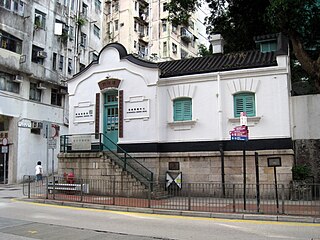| Former Wan Chai Market | |
|---|---|
灣仔街市 | |
 (Old) Wan Chai Market | |
| General information | |
| Architectural style | Streamline Moderne |
| Classification | Grade III Historic Building |
| Location | Wan Chai, Hong Kong Island |
| Address | 264 Queen's Road East |
| Country | Hong Kong |
| Completed | 1937 |
| Relocated | September 2008 |
| Wan Chai Market | |||||||||
|---|---|---|---|---|---|---|---|---|---|
| Traditional Chinese | 灣仔街市 | ||||||||
| |||||||||

The former Wan Chai Market building was constructed in 1937. It is located at 264 Queen's Road East, at the Wan Chai Road crossing, opposite Stone Nullah Lane in Wan Chai, Hong Kong Island. [1] It is a Grade III Historic Building. [2]

Queen's Road East is a street in Wan Chai, in the north of Hong Kong Island, Hong Kong, connecting Admiralty in the west to Happy Valley in the east. Queen's Road East is one of the four sections of Queen's Road, and historically included Queensway.

Wan Chai Road (灣仔道) is a main road in Wan Chai, on the north side of Hong Kong Island.

Stone Nullah Lane is a one-way street in Wan Chai, Hong Kong Island, Hong Kong. Named after the water channel that until 1959 ran down its middle, it stretches from Lung On Street to Queen's Road East. The street is noted for its historical landmarks, most notably the Blue House and Wan Chai Pak Tai Temple.
Contents
Its architectural style is influenced by Streamline Moderne (also known as Streamlined Moderne or Art Moderne) architecture, a popular style of building of the 1930s. It is often erroneously referred to as a Bauhaus-style building. [3] [4]

Streamline Moderne is an international style of Art Deco architecture and design that emerged in the 1930s. It was inspired by aerodynamic design. Streamline architecture emphasized curving forms, long horizontal lines, and sometimes nautical elements. In industrial design, it was used in railroad locomotives, telephones, toasters, buses, appliances, and other devices to give the impression of sleekness and modernity.

The Staatliches Bauhaus, commonly known as the Bauhaus, was a German art school operational from 1919 to 1933 that combined crafts and the fine arts, and was famous for the approach to design that it publicized and taught.
Wan Chai Market, the wet market housed in the old market building since 1937, has moved into the new market complex on the lower levels of "The Zenith", a newly built residential development located just opposite to the market building, in September 2008.

In Hong Kong English and Singapore English, a wet market is a market selling fresh meat, fish, produce, and other perishable goods as distinguished from "dry markets" which sell durable goods such as fabric and electronics.
The Wan Chai Market was initially a wet place where merchants would sell their belongings. It was also used as a garage for Bullock Carts and thus was called the 'Wet Garage' (Chinese :濕車庫). It was named in 1917.

Traditional Chinese characters are Chinese characters in any character set that does not contain newly created characters or character substitutions performed after 1946. They are most commonly the characters in the standardized character sets of Taiwan, of Hong Kong and Macau. The modern shapes of traditional Chinese characters first appeared with the emergence of the clerical script during the Han dynasty and have been more or less stable since the 5th century.


























